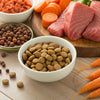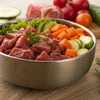What Does a Raw Dog Food Diet Consist Of? A Comprehensive Guide for Pet Owners
- Houndsy
Table of Contents
- Introduction
- The Basics of Raw Dog Food
- Essential Ingredients
- Benefits and Risks of a Raw Food Diet
- Transitioning to a Raw Diet
- Conclusion
Introduction
Did you know that the raw dog food diet is growing in popularity among pet owners? As we learn more about nutrition and health for our furry companions, many of us find ourselves asking, “What does a raw dog food diet consist of?” This inquiry isn't merely academic; the approach to our dogs' nutrition can profoundly affect their health, energy levels, and overall quality of life.
The raw food diet movement is rooted in the idea that our pets should eat in a way that is more consistent with their evolutionary diets—a far cry from the highly processed kibble often found on store shelves. This blog post aims to shed light on the essentials of a raw dog food diet, sharing both the potential benefits and the considerations that come with it. By the end of this article, we hope you feel informed about how you might incorporate raw feeding into your own pet care routine, either through homemade solutions or commercially available options.
We'll explore:
- The Basics of Raw Dog Food: Understanding what defines a raw diet.
- Essential Ingredients: What should be included to ensure a balanced diet.
- Benefits and Risks: Both sides of the raw feeding debate.
- Transitioning to a Raw Diet: Step-by-step guidance for pet owners.
- Conclusion & FAQ: A wrap-up of key points and answers to your pressing questions.
So, let’s dig in deeper to discover what it means to feed our potently loving pets raw food!
The Basics of Raw Dog Food
The raw food diet, often referred to as BARF (Biologically Appropriate Raw Food), consists of uncooked, natural ingredients that mimic what our dogs might have eaten in the wild. This concept was popularized in the 1990s by veterinarian Dr. Ian Billinghurst, who posited that a natural, meat-based diet could improve canine health outcomes.
Types of Raw Diets
- BARF Diet: Focuses on raw meat, bones, and often includes fruits, vegetables, and supplements to promote overall health.
- Prey Model Diet (PMR): Emulates the diet of a wild predator, comprising predominantly of whole animals (like rabbits or chickens) including muscle meat, organs, and bones without extra plant material.
The fundamental idea behind raw feeding is that it aligns our pet’s diet more closely to what their ancestors consumed, promoting better digestion, coat health, and overall vitality.
Essential Ingredients
So, what does a raw dog food diet consist of at its core? It's about achieving balance and variety in components, ensuring that your dog receives all the necessary nutrients without relying heavily on processed foods.
Common Components of a Raw Diet
Here’s a breakdown of the primary ingredients in a well-rounded raw dog food diet:
-
Muscle Meat (70%): This makes up the bulk of the diet and includes cuts such as beef, chicken, or turkey. Muscle meats provide essential protein and amino acids vital for muscle maintenance and energy.
-
Raw Meaty Bones (10%): Not only do these bones provide calcium and phosphorus, which are critical for healthy bones and teeth, but they also help maintain oral hygiene by reducing tartar build-up.
-
Organ Meats (10%): These include nutrient-rich parts like liver and kidneys, which offer vital vitamins and minerals. Liver is especially beneficial, providing essential fat-soluble vitamins A, D, E, and K.
-
Vegetables & Fruits (10%): While not necessarily essential, integrating dog-friendly veggies (such as broccoli, carrots, and spinach) and fruits (like apples and blueberries) can enhance the diet with antioxidants, fiber, and additional vitamins.
-
Supplements: Depending on your chosen ingredients, occasional supplementation with things like fish oil (for omega-3s), kelp (for trace minerals), or eggshells (for calcium) can help round out the nutritional profile.
Sample Ingredient Ratio (BARF)
- 70% Muscle Meat
- 10% Raw Meaty Bones
- 10% Organs (at least 5% should be liver)
- 10% Vegetables and Fruits or Dairy
Understanding these ratios can guide us toward creating balanced meals for our dogs.
Benefits and Risks of a Raw Food Diet
As with any dietary shift, transitioning to a raw dog food diet involves weighing the pros and cons. Here, we'll break these down so you can make an informed choice.
Potential Benefits
-
Shinier Coats & Healthier Skin: Raw diets are often abundant in omega fatty acids, which can support skin health and contribute to a gleaming coat.
-
Better Digestion: Many dog owners report that their pets experience fewer digestive issues after switching to a raw diet, often resulting in smaller, firmer stools.
-
Improved Energy Levels: A diet high in whole foods often translates to more vitality, thus allowing dogs to be their energetic selves.
-
Stronger Teeth: Chewing raw meaty bones promotes healthy teeth and gums, helping reduce dental issues often associated with kibble diets.
Considerations and Risks
-
Bacterial Contamination: Handling raw meat introduces risks of pathogens like Salmonella or E. coli. Safety precautions, such as proper hygiene and food handling, are essential.
-
Nutritional Imbalance: If not carefully planned, raw diets can result in deficiencies or excesses of certain nutrients, so it's crucial to ensure that the diet is well-balanced.
-
Bone Safety: Raw bones can pose choking hazards or cause dental fractures. Always supervise your dog while they chew on bones and consult your veterinarian regarding appropriate sizes.
-
Health Issues and Age Considerations: Puppies, senior dogs, and dogs with certain medical conditions may need specially formulated diets or should consult their veterinarian before transitioning to raw foods.
Transitioning to a Raw Diet
Switching to a raw dog food diet is not something that should be done overnight. Gradual changes can help prevent digestive upset, allowing your dog's system to adjust.
Step-by-Step Transition Guide
-
Start Slow: Begin with a small portion of raw food mixed with your dog's usual kibble or cooked diet.
-
Monitor Changes: During the transition, observe your dog's stools, energy levels, and general demeanor. Some digestive discomfort may arise initially but should normalize with time.
-
Increase Raw Proportion: Gradually adjust the ratio of raw food to cooked food over 7-10 days, gently phasing out the kibble.
-
Introduce Variety: Once your dog is fully transitioned to raw, introduce a variety of proteins (e.g., beef, chicken, fish) and ensure that their diet remains diverse for optimal nutrition.
-
Regular Vet Checkups: Schedule routine vet visits to monitor your dog’s health and discuss their dietary needs, ensuring that they thrive on their new nutrition regime.
Conclusion
In summary, a raw dog food diet can be a beneficial option for many dogs, focused on providing natural, wholesome ingredients that reflect their evolutionary needs. While the potential benefits are impressive—from healthier coats to improved digestion—it is essential to approach this diet with caution, considering the necessary precautions to prevent risks associated with bacterial contamination and nutritional imbalance. Thoughtfully transitioning your dog to a raw diet involves a careful introduction of a variety of ingredients tailored to your dog's specific needs.
If you’re considering making feeding time more enjoyable and efficient for you and your furry friend, we invite you to explore the advantages of the Houndsy Kibble Dispenser. It ensures perfect portion control, making meal times consistent and easy while enhancing your pet’s feeding experience.
FAQ
1. What exactly does a raw dog food diet consist of? A raw dog food diet consists of uncooked meats, raw meaty bones, organs, and some fruits and vegetables to provide a balanced nutritional profile.
2. Are there risks associated with feeding raw food to dogs? Yes, potential risks include bacterial contamination, nutritional imbalances, and safety concerns regarding bones. It is crucial to handle food safely and consult your vet for dietary advice.
3. How can I transition my dog to a raw food diet? Start by mixing small amounts of raw food with their current diet and gradually increase the raw portion over 7-10 days, monitoring for any digestive changes.
4. Can all dogs eat a raw diet? While many dogs do well on a raw diet, those with specific health issues (like kidney disease or pancreatitis) or puppies may require specially formulated food—consult your veterinarian.
5. How do I ensure my dog’s raw diet is balanced? Consult with a vet to develop a meal plan that includes the right proportions of muscle meat, bones, organs, and supplements to meet your dog's nutritional needs.












